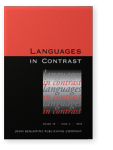Vol. 18:2 (2018) ► pp.230–251
Contrasting pronominal subjects
A cross-linguistic corpus study of English, Italian and Slovene
Pronominal subject use constitutes a potential challenge in translation because of cross-linguistic differences: while the subject must be expressed in non-null subject languages, this is not necessary in null subject languages. The aim of the paper is twofold: first, to show that the type of source language influences the frequency of personal pronouns in translation, and second, to establish whether translations into a null subject language differ from comparable target language originals in terms of pronominal subject use. The study is based on the analysis of a 625,000-word corpus comprising original and translated popular science texts in Slovene and the corresponding source texts in English and Italian. The results confirm that pronominal subjects are more frequent in translations from English, a non-null subject language; furthermore, they are more frequent in translations than in comparable originals. Untypical cohesive patterns are identified in translations and possible reasons for their presence are explored.
Article outline
- 1.Introduction
- 2.Pronominal subjects as cohesive devices
- 3.Corpus and procedure
- 3.1Corpus
- 3.2Procedure
- 4.Results
- 4.1Frequency of pronominal subjects
- 4.2Classification of pronominal subjects
- 4.2.1Disambiguation
- Contrast
- Comparison
- Coordinate structure
- 4.2.2Emphasis
- 4.2.1Disambiguation
- 4.3Source text – target text correspondence
- 5.Discussion
- 6.Conclusion
- Acknowledgements
- Notes
-
References
